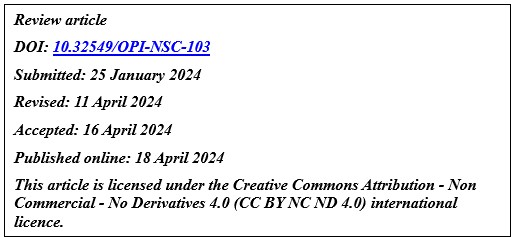Carla Rizzo 1, Flavio Marti 2, Luca Perrozzi 3*, Lucia Mauro 4
- Complex Anesthesia, Resuscitation and Intensive Care Unit, IRCCS Hospital Physiotherapy Institutes, Rome (Italy).
- Department of Health Professions AO San Camillo Forlanini, Master’s Degree Course in Nursing and Midwifery Sciences, “Sapienza” University of Rome, San Camillo section, Rome (Italy).
- Accident and Emergency and Specialist Surgery Department, A.O. San Camillo Forlanini, Rome (Italy).
- Department of Surgical Sciences, Elective Surgery Block, A.O. San Camillo Forlanini, Rome (Italy).
*Corresponding Author: Luca Perrozzi, Department of Accident and Emergency and Specialist Surgery, Azienda Ospedaliera San Camillo Forlanini, C.ne Gianicolense 87, 00159 Rome (Italy). Email: lucaperrozzi@yahoo.it
Cite this article
ABSTRACT
Introduction: Healthcare organisations require optimal leadership to achieve goals and deliver high-quality services. Leadership is the ability to influence employee behaviour and beliefs and is an essential element of a successful organisation. Improving job satisfaction is a key objective in addressing the challenges related to achieving and maintaining quality standards, ensuring patient satisfaction and staff retention. Similarly, transformational leadership has positive effects on nurses’ job satisfaction and promotes organisational wellbeing in the workplace.
Objective: The purpose of the review is to describe transformational leadership and job satisfaction in the nursing profession through a narrative revision.
Materials and methods: The bibliographic research was carried out between September 2022 and March 2024 by consulting databases such as PubMed, CINAHL, and PsycInfo, with time limits of 12 years and Italian and English language filters. All items deemed relevant have been stored and managed with the Zotero IT platform.
Results: 16 studies were examined: 1 comparative study, 5 descriptive correlational studies, 1 meta-analysis, 1 systematic review, 4 cross-sectional studies, 2 mixed method studies and 2 unspecified studies. The results of this study are consistent with transformational leadership theory, which highlights the leader’s role in providing employees with supportive work environments that result in higher levels of job satisfaction and efficiency.
Conclusions: The skills of a transformative leader, such as the ability to listen, provide support, and promote fairness and recognition, are fundamental to increasing nurses’ job satisfaction and sustaining environments with a high level of quality of care. Healthcare managers must protect the quality of work undertaken by staff, implementing strategies that can improve nurses’ working conditions.
Keywords: Transformational Leadership; Job Satisfaction; Nurse; Work environment.
INTRODUCTION
Healthcare organisations are social systems in which human resources are the most important factor for the delivery of health care. Such organisations require optimal leadership to achieve goals and deliver high-quality services [1,2]. Leadership is the ability to influence employee attitudes and beliefs and is an essential element of successful and efficient organisations [3,4]. The current challenges of the health system require the presence of flexible and efficient managers [5] because the complexity of nurses’ tasks requires complex leadership skills [6]. A wide range of studies have described the favourable outcomes of positive leadership, in particular, the transformational leadership style [7–9]. Transformational leadership motivates problem-solving and intellectual stimulation by influencing staff engagement in the organisation’s mission. Such leaders stimulate nurses to use problem-solving strategies and provide patient care autonomously and responsibly [10]. Certain studies suggest that transformative leaders have positive effects on the wellbeing and job satisfaction of healthcare workers [4,11]. In addition, transformational leadership transforms nurses’ goals and values for the benefit of the nursing profession [12] and work organisation and promotes team communication and collaboration, the work environment and organisational culture [13].
Work satisfaction, defined as “a pleasant emotional state that derives from the judgment of one’s work or work experience” [14], is extremely important both for nursing managers and wellbeing of nurses in the workplace. Improving job satisfaction is a key objective in addressing the challenges related to achieving and maintaining quality standards, ensuring patient satisfaction and staff retention [15,16].
The more satisfied employees are, the more motivated they are to work and the greater the possibility of achieving the objectives, with an increase in productivity and quality. Job satisfaction cannot be overlooked if improving work performance is a priority of the organisation [17].
As part of the study, the authors described transformational leadership and staff job satisfaction, with the aim of synthesising the evidence that describes these aspects in the nursing profession.
Transformational leadership theorists indicate that leaders use socialised power to elevate and empower subordinates and provide the resources needed to achieve more than they thought possible in their work. Intrinsic motivation strategies support nursing autonomy, competence and relationship with others in the context of a mutually supportive environment to foster social and personal development at the service of the organisation’s vision, mission, values, aims and objectives. In this way, subordinate nursing staff enjoy satisfaction in overcoming work challenges.
Nursing leaders must be proactive in recognising and addressing the job satisfaction needs of direct care nursing staff in order to maintain high-quality staff as well as the quality of patient care and healthcare environments [18].
Objective of the study
The purpose of the review is to describe transformational leadership and job satisfaction in the nursing profession through a narrative revision of the literature.
MATERIALS AND METHODS
The bibliographic research was carried out from 1 September 2022 to 31 March 2024 by consulting the following databases: PubMed, Cinhal, and PsycInfo, with time limits of 10 years and Italian and English language filters. The research question was formulated according to the PICO method, as shown in Table 1.

Table 1. Research question formulated according to the PICO method
The following keywords were used: “transformational leadership”, “job satisfaction”, and “nurse*”. Within the study, all the articles that dealt with transformational leadership and job satisfaction in the nursing profession with a time limit of 12 years (from January 2012 to March 2024) were included in English and Italian. All articles written in other languages were excluded.
RESULTS
During the bibliographic research, the search string generated a listing of 223 articles on 3 different databases (PubMed, Cinhal, and PsycInfo) (figure 1).
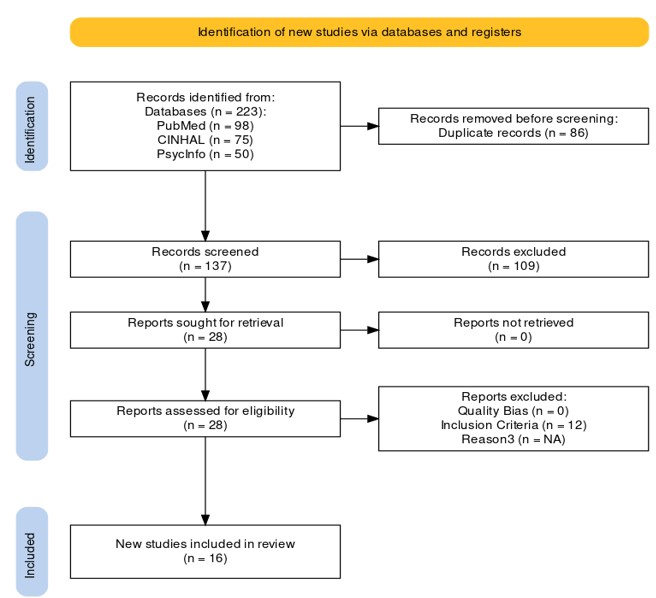
Figure 1. “PRISMA Statement” flowchart[19].
All items were managed using the Zotero IT platform. After the duplicates were removed, 137 articles remained. Selection by title and by abstract led to the exclusion of 109 articles. For the subsequent critical analysis, the 28 articles were read and evaluated in their entirety to identify and understand the content. On reading the full texts, 12 articles were discarded because they failed to comply with the inclusion criteria. A total of 16 studies were evaluated, broken down as follows: 1 comparative study, 5 descriptive correlational studies, 1 meta-analysis, 1 systematic review, 4 cross-sectional studies, 2 mixed method studies, 2 unspecified studies (see Table 2). Fifteen articles were published in English and one in Italian.
Evaluation of the quality of the studies
The articles were selected and evaluated using the checklists from “JBI Critical Appraisal Tools” [20]. A total of 16 articles were reviewed. To classify the studies in terms of quality, the overall score was calculated based on the number of “yes” answers. The included studies had at least 6 out of 10 of the items included in the checklists chosen by the authors of this study.
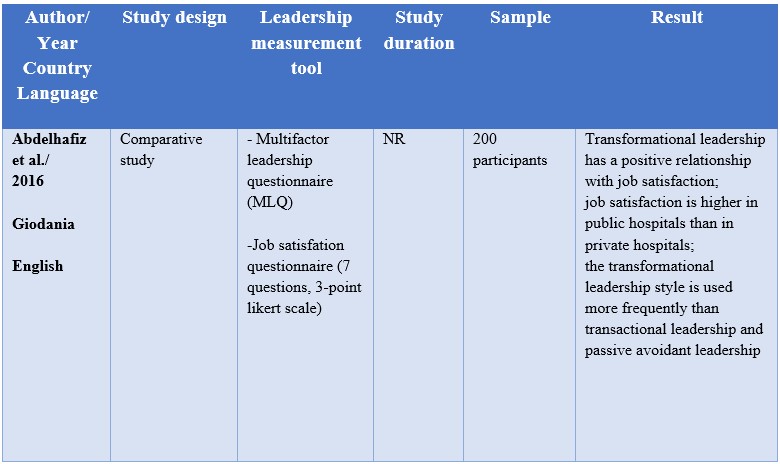
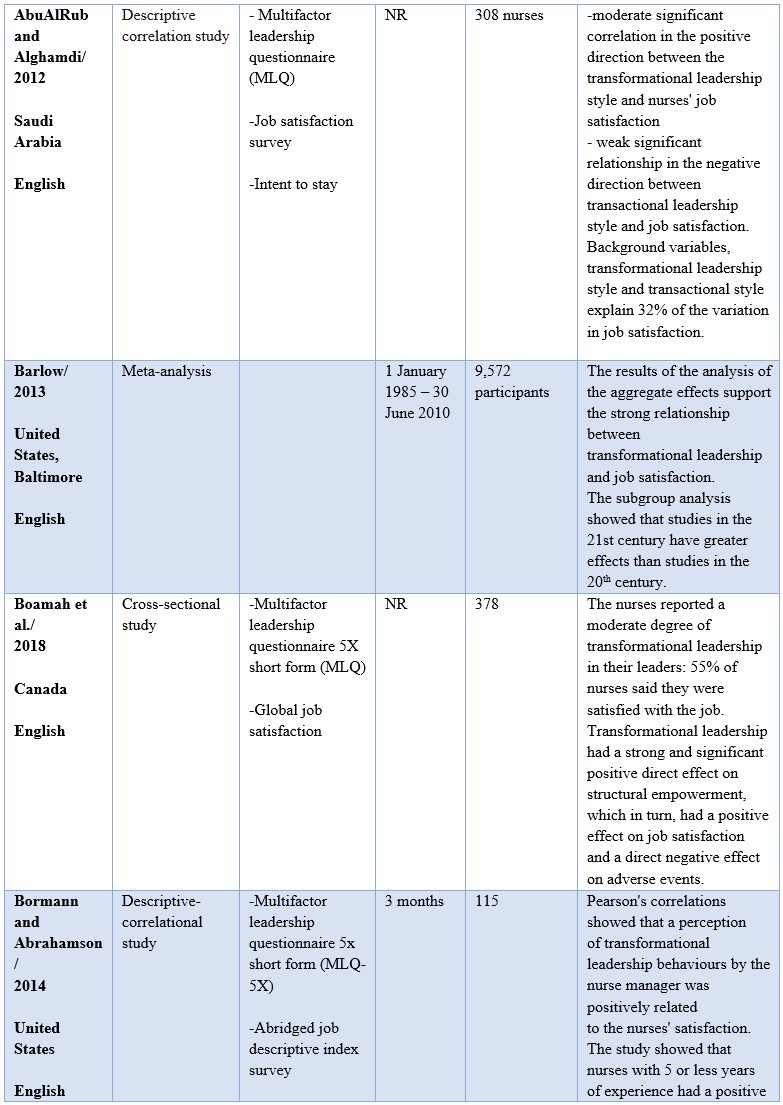
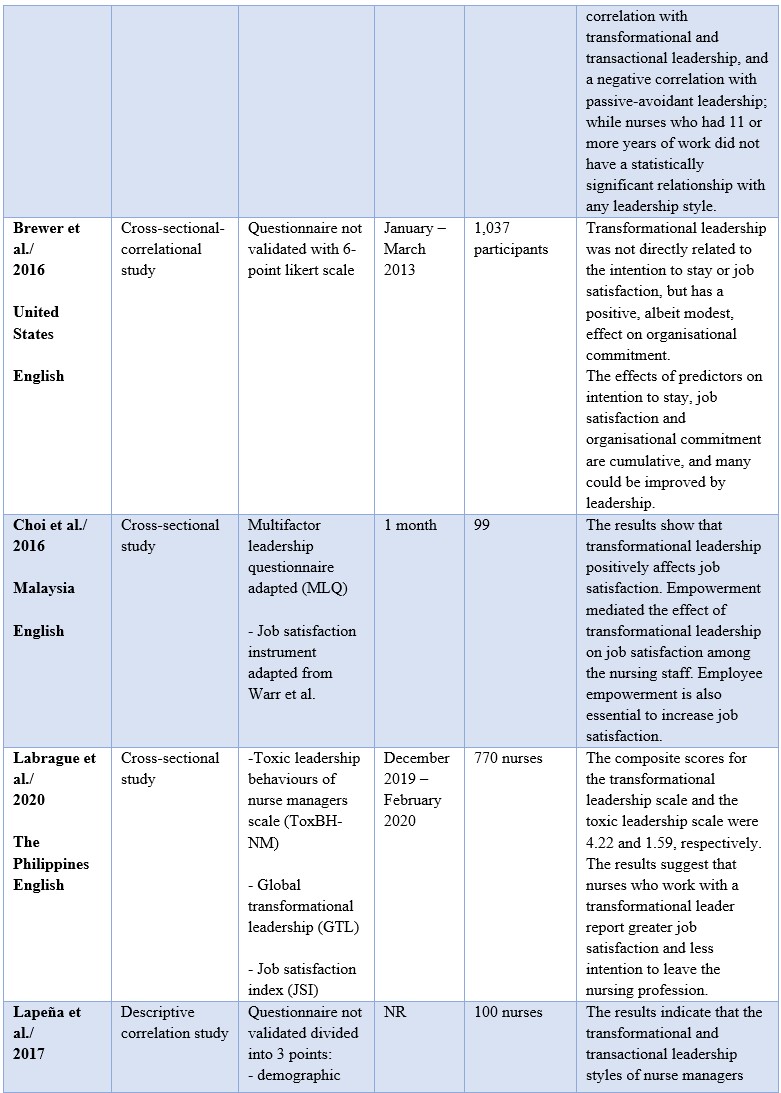
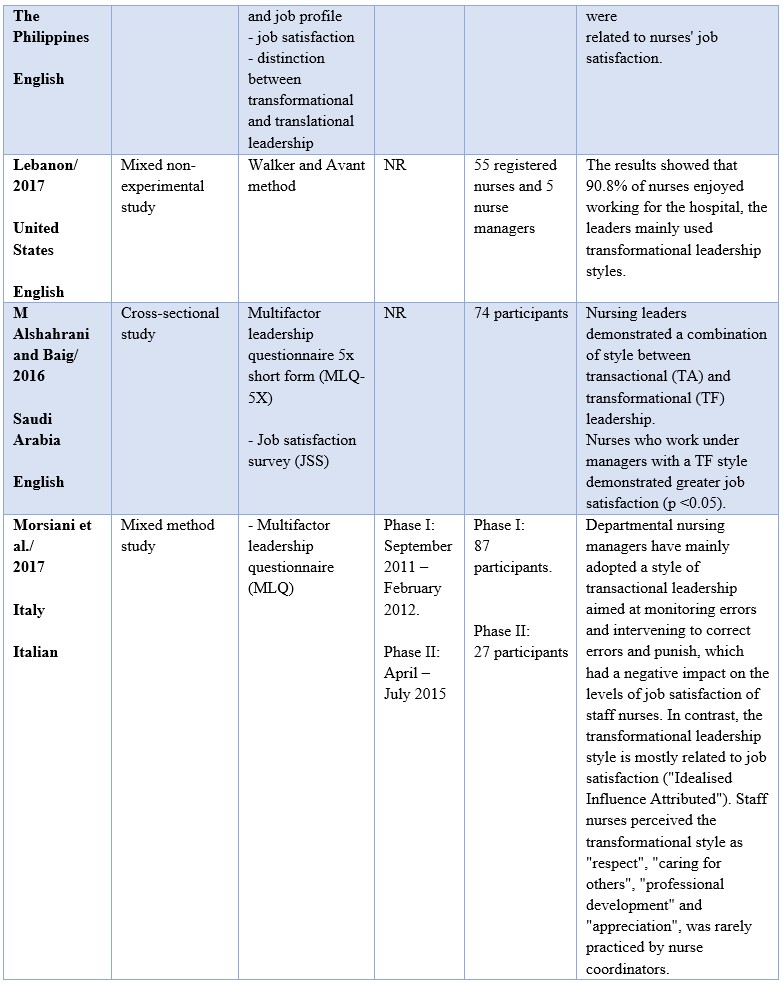
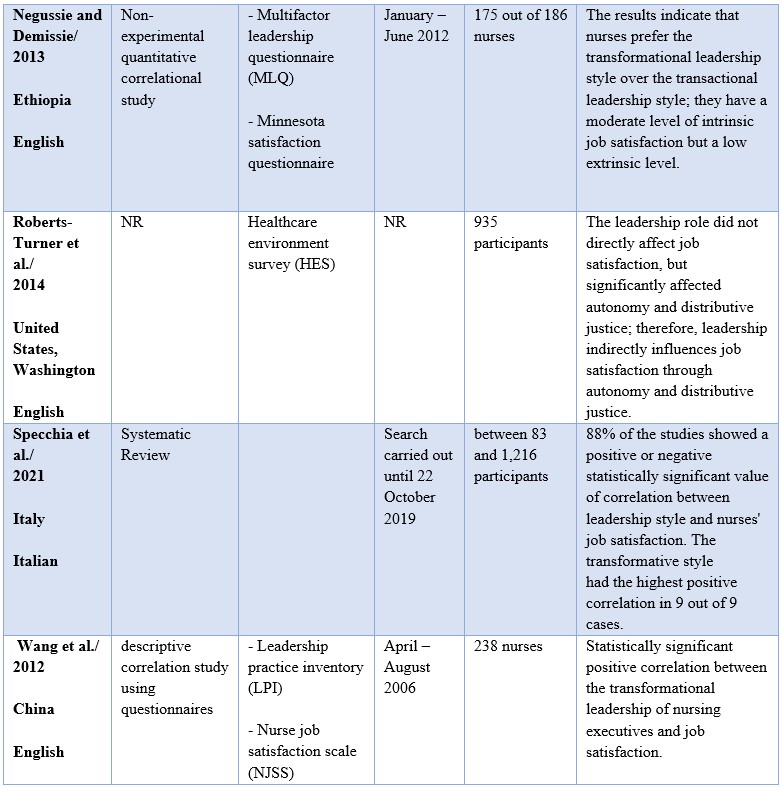
Table 2. Summary of results
DISCUSSION
The literature considered demonstrates that the transformational leadership style can positively influence job satisfaction in most of the included studies, regardless of the sample, the country, or the type of study chosen [21–34]. Only two studies do not describe a positive link between the variables analysed [35,36].
The results of this review highlight that the characteristics of a transformative leader – such as listening, support, fairness and recognition – are fundamental to increasing nurses’ job satisfaction and creating environments with superior quality of care.
For example, the results of the systematic review by Specchia [31] and AbuAlRub and Alghamdi [34] emphasise that leaders who adopt a transformative style promote greater job satisfaction among nursing staff than those who adopt a transactional style. In fact, transformational leadership shows a significant and moderate correlation with job satisfaction (r = 0.45, p < 0.001), while transactional leadership shows a weak significant relationship with job satisfaction (r = -0.14, p < 0.01)[34]. In fact, the strength of transformational leaders is that they dedicate time to teaching and coaching nurses, focus on developing and improving their strengths, and provide advice for their professional and personal development [31].
These results are consistent with previous studies by Al-Hussami [37] and Bass [38]. These studies support the idea that nurses who worked with leaders who showed transformational leadership styles were more satisfied. In fact, these leaders taught and trained nurses, providing advice for professional development, treating them as individuals, listening to their concerns, and promoting their personal development[39].
Another issue concerns the correlation between transformational leadership, job satisfaction and the intention to leave work. For example, Labrague’s study [26] shows how the transformational leadership of nursing executives influences nurses’ job satisfaction and their intention to leave the profession despite the demographic characteristics (age, sex, sentimental situation, full time). Specifically, it differentiates toxic leadership from transformational leadership. Toxic leadership is significantly correlated with dissatisfaction at work (r = -0.19, p <0.001), absenteeism (r = 0.23, p < 0.001), psychological distress (r = 0.09, p < 0.05), organisational turnover intention (r = 0.11, p < 0.01) and professional turnover intention (r = 0.14, p < 0.001). Instead, transformational leadership is significantly related to job satisfaction (r = 0.37, p < 0.001), absenteeism (r = -0.13, p < 0.001) and the intention of organisational turnover (r = -0.08, p < 0.05). This underlines how important it is to educate leaders and nurse managers within healthcare facilities and develop behaviours that help and support staff. Indeed, maintaining a quality working environment has a significant impact on the retention of nurses and decreases the intention to leave the profession or nurse turnover.
In contrast, the results of the study by AbuAlRub and Alghamdi [34] indicate that the relationship between the transformational leadership style and the level of intention to stay at work was not statistically significant (r = 0.08, p = 0.14), so the transformational leadership style had no effect on the intention to stay at work.
Even if the results regarding intention to leave the profession are mixed, transformational leadership can provide supportive work environments that result in higher levels of job satisfaction and effectiveness [39]. In fact, by strengthening solid relationships with staff, transformational leaders understand the needs of nurses, they encourage staff to develop skills and autonomy in order to empower them to act.
The studies by Bohaman [23] and Choi [25] analysed the role that structural empowerment has in the relationship between job satisfaction and the transformational leadership style. Structural empowerment, in line with other previous research, [40–42] influences job satisfaction, organisational commitment[41], work commitment[43], lower levels of burnout and work stress [41] and turnover intentions[41,44]. This is due to the characteristics of the transformational leader, such as the ability to listen, inspire staff and stimulate individual and group skills. We can therefore state from these studies [23,25] that empowerment has a positive influence on job satisfaction.
In the study by Borman and Abrahamson [24], it emerged that nurses who worked for 5 or fewer years within the hospital had a statistically positive correlation with transformational and transactional leadership, while nurses who worked for 11 or more years did not have any type of significant relationship with any leadership style. For those who worked for 5 or fewer years, job satisfaction was mainly related to promotion opportunities, while for nursing staff of 11 or more years it had a stronger correlation for supervision. Therefore, leaders must understand the needs of their employees based on individual differences and their work experience.
The studies by McVicar and Laschinger [35,36] did not find a direct correlation between transformational leadership and job satisfaction. Roberts and Turner [36] highlighted how autonomy and distributive justice positively affect job satisfaction (0.503, p < 0.001; 0.272, p < 0.001). Within the study, the authors emphasise that autonomy represents a characteristic of transformational leadership, and distributive justice represents transactional leadership. It follows that, even if a direct relationship between the variables considered has not been found, autonomy represents one of the fundamental characteristics of the transformational leadership style. This implies that an increase in autonomy and distributive justice would increase job satisfaction.
Conversely, according to Brewer,[35] transformational leadership was not a significant predictor of job satisfaction. The variables with positive significant coefficients related to job satisfaction were organisational commitment, autonomy, tutor support and promotional opportunities. Considering job satisfaction as a dependent variable, a nurse who goes from a low organisational commitment value to a very high organisational commitment value is 12.6% more likely to be satisfied.
The Barlow meta-analysis [22] showed a very strong relationship between transformational leadership and job satisfaction: the aggregate result of the studies generated by the estimates of the size of the effect are more incisive and representative than the outcomes of individual studies examined. The study shows how transformational leaders stimulate and empower nurses to provide the resources needed to achieve greater results. In fact, staff intrinsic motivation strategies support autonomy, competence, and nursing relationships to create a mutually supportive work environment that promotes social and individual development at the service of the organisation’s mission, values, and goals. In addition, the results report that the relationship between transformational leadership/job satisfaction has strengthened over time. The subgroup analysis showed that studies in the 21st century have stronger effects than studies in the 20th century. This can be explained by the identification of the Magnet design health and nursing excellence programmes, which notably increased in the 21st century [22]. Therefore, strategies must be implemented within hospitals today to increase the job satisfaction of nurses by assessing staff satisfaction on an annual basis and improving working conditions.
Another result to consider concerns the difference reported in various studies within the Barlow meta-analysis [45–47] between the greater satisfaction detected by nurses in indirect or mixed care (nurse administrators, specialised nurses) compared to staff engaged in direct care (ward nurses). This can be explained by the great shortage of nurses that is being experienced worldwide, which leads to greater workloads, work stress, burnout, intentions to leave the profession and turnovers that strongly affect job satisfaction. This is why nursing leaders are fundamental in order to understand and recognise the needs of their staff, to maintain a high quality of work, as direct care provides essential services for patients.
A study conducted in Italy by Morsiani[29] engaged focus groups to identify the main characteristics of a leader in relation to the achievement of satisfaction:
- Professional recognition. Job satisfaction depends on professional recognition, that is, giving value to the work of a nurse and expressing appreciation for the work of the staff.
- Fairness. Nursing leaders must adopt the same behaviour, be honest with all staff members and be objective about mistakes at work.
- Care of the individual. If a leader supports and listens to their staff, the latter will be more likely to experience job satisfaction. Often, the role of nurses, especially in Italy, is not recognised at a social and economic level. The first in the field who must defend the profession are precisely the leaders who must lead the profession to its emancipation, while maintaining relationships with other professionals. In fact, it is not a war between professions but an endeavour to enhance the value of the nursing profession.
- Support. Globally, the shortage of nurses impacts patient care, as the same care result must be achieved in the same time and with fewer human and material resources. Leaders should not put themselves on a different plane than nurses but should be present in the ward and help them in case of need. In addition, being present in the department is an opportunity to check the work of the staff and recognise what the errors may be within the care path and look for strategies to improve it.
- Listening. Being present also means knowing how to listen and understand the needs of the staff, such as shift scheduling and the difficulties encountered at work.
- Staff appreciation. The nursing manager must promote staff development by seeking to improve nurses, both individually and as a group. Training, feedback, and refresher courses are crucial tools to ensure that staff have greater autonomy and responsibility.
- Team development. Another important issue is teamwork. This study revealed the extent to which staff did not feel part of a work group. Teamwork is essential to ensuring collaboration, compensating for others’ inadequacies, and sharing common goals and strategies to achieve patient satisfaction.
Therefore, there is scope for future studies employing a more rigorous research approach that would establish causal links between the variables considered and the appropriateness of generalising the results.
CONCLUSIONS
The review found that transformational leadership can have a positive influence on nursing job satisfaction levels. Therefore, nursing leadership assumes a fundamental role in influencing the perception that nurses have of their organisation. A leadership style that promotes nurses’ autonomy, support, and empowerment can improve job satisfaction, organisational commitment, and nurses’ intention to remain in their position while reducing emotional exhaustion [6]. This means that transformational leaders, through their stimulating and motivating behaviour, can induce changes in the psychological states of workers within organisations. In addition, some studies have shown how the adoption of the transformational leadership style can indirectly influence job satisfaction through the development and strengthening of nurses’ sense of empowerment [23,25]. Within healthcare organisations, leadership plays a key role in providing effective and efficient care and translates into positive outcomes for professionals, patients and the work environment. It is therefore necessary to identify and fill the current gaps in the skills and abilities of nursing leaders through educational activities in institutions, underlining the importance of a two-way communication process and mutual trust between managers and nursing staff. The purpose of the review was to offer an overview of a current topic, as both job satisfaction and transformational leadership are two fundamental issues for the creation of a healthy and efficient work environment. Despite the fact that leadership quality and job satisfaction can be assessed using proven and generalizable measurement tools, few studies adopt such methods, and they thus fail to draw conclusions from the relationship between pertinent variables. For the future, the authors suggest conducting studies that can correlate transformational leadership and job satisfaction to obtain more generalizable results because these issues are based much more on empirical experience than on robust scientific evidence.
Limitations of the study
Although the research met the objective of this study, the review has limitations. For example, one of the limitations of a narrative review concerns the methodology itself; whereas a systematic review has a clear and obligatory a priori methodology, the narrative review approach lacks a research protocol. Another limitation is the interpretation bias of the results, which can bring to light only a part of the chosen topic. To confirm what has been described in this review, other studies are needed that can obtain certain, reproducible and generalizable results. In addition, the results that emerged from the other studies were evaluated by means of self-assessment questionnaires, which are frequently associated with response bias.
Funding
This study did not receive any form of funding.
Conflict of interest
The authors declare that they have no conflicts of interest associated with this study.
REFERENCES
[1] Huber D. Leadership and Nursing Care Management. 3rd ed. Saunders Elsevier, Philadelphia PA: 2006. [2] Frisicale EM, Grossi A, Ccacciatore P, Carini E, Villani L, Pezzullo AM, et al. The need of leadership in managing healthcare and policy-making – G. Ital. Health Technol. Assess. 2019. [3] Cleary M, Horsfall J, Jackson D, Muthulakshmi P, Hunt GE. Recent graduate nurse views of nursing, work and leadership. J Clin Nurs 2013;22:2904–11. https://doi.org/10.1111/jocn.12230. [4] Mannix J, Wilkes L, Daly J. ‘Watching an artist at work’: aesthetic leadership in clinical nursing workplaces. J Clin Nurs 2015;24:3511–8. https://doi.org/10.1111/jocn.12956. [5] Casida J, Parker J. Staff nurse perceptions of nurse manager leadership styles and outcomes: Nurse manager leadership styles and outcomes. J Nurs Manag 2011;19:478–86. https://doi.org/10.1111/j.1365-2834.2011.01252.x. [6] Laschinger HKS, Wong CA, Cummings GG, Grau AL. Resonant leadership and workplace empowerment: the value of positive organizational cultures in reducing workplace incivility. Nurs Econ 2014;32:5–15, 44; quiz 16. [7] Al-Yami M, Galdas P, Watson R. Leadership style and organisational commitment among nursing staff in Saudi Arabia. J Nurs Manag 2018;26:531–9. https://doi.org/10.1111/jonm.12578. [8] Cummings GG, Tate K, Lee S, Wong CA, Paananen T, Micaroni SPM, et al. Leadership styles and outcome patterns for the nursing workforce and work environment: A systematic review. Int J Nurs Stud 2018;85:19–60. https://doi.org/10.1016/j.ijnurstu.2018.04.016. [9] Umrani WA, Afsar B. How transformational leadership impacts innovative work behaviour among nurses. Br J Healthc Manag 2019;25:1–16. https://doi.org/10.12968/bjhc.2018.0069. [10] Madathil R, Heck NC, Schuldberg D. Burnout in Psychiatric Nursing: Examining the Interplay of Autonomy, Leadership Style, and Depressive Symptoms. Arch Psychiatr Nurs 2014;28:160–6. https://doi.org/10.1016/j.apnu.2014.01.002. [11] Robbins B, Davidhizar R. Transformational Leadership in Health Care Today. Health Care Manag 2020;39:117–21. https://doi.org/10.1097/HCM.0000000000000296. [12] Lievens I, Vlerick P. Transformational leadership and safety performance among nurses: the mediating role of knowledge-related job characteristics. J Adv Nurs 2014;70:651–61. https://doi.org/10.1111/jan.12229. [13] Spies LA, Gray J, Opollo JG, Mbalinda S, Nabirye R, Asher CA. Transformational leadership as a framework for nurse education about hypertension in Uganda. Nurse Educ Today 2018;64:172–4. https://doi.org/10.1016/j.nedt.2018.02.009. [14] Locke EA. “Job satisfaction reconsidered”: Reconsidered. Am Psychol 1978;33:854–5. https://doi.org/10.1037/0003-066X.33.9.854. [15] De Simone S, Planta A, Cicotto G. Il ruolo delle capacità agentiche nelle intenzioni di turnover del personale infermieristico 2018. [16] Khamisa N, Oldenburg B, Peltzer K, Ilic D. Work related stress, burnout, job satisfaction and general health of nurses. Int J Environ Res Public Health 2015;12:652–66. https://doi.org/10.3390/ijerph120100652. [17] Yang F-H, Wu M, Chang C-C, Chien Y. Elucidating the Relationships among Transformational Leadership, Job Satisfaction, Commitment Foci and Commitment Bases in the Public Sector. Public Pers Manag 2011;40:265–78. https://doi.org/10.1177/009102601104000306. [18] Aiken LH, Clarke SP, Sloane DM, Lake ET, Cheney T. Effects of hospital care environment on patient mortality and nurse outcomes. J Nurs Adm 2008;38:223–9. https://doi.org/10.1097/01.NNA.0000312773.42352.d7. [19] Haddaway NR, Page MJ, Pritchard CC, McGuinness LA. PRISMA2020: An R package and Shiny app for producing PRISMA 2020-compliant flow diagrams, with interactivity for optimised digital transparency and Open Synthesis. Campbell Syst Rev 2022;18:e1230. https://doi.org/10.1002/cl2.1230. [20] Munn Z, Barker TH, Moola S, Tufanaru C, Stern C, McArthur A, et al. Methodological quality of case series studies: an introduction to the JBI critical appraisal tool. JBI Database Syst Rev Implement Rep 2019;Publish Ahead of Print. https://doi.org/10.11124/JBISRIR-D-19-00099. [21] Abdelhafiz IM, Alloubani AM, Almatari M. Impact of leadership styles adopted by head nurses on job satisfaction: a comparative study between governmental and private hospitals in Jordan. J Nurs Manag 2016;24:384–92. https://doi.org/10.1111/jonm.12333. [22] Barlow KM. A Meta-Analysis of Transformational Leadership and Subordinate Nursing Personnel Organizational Commitment, Job Satisfaction, and Turnover Intentions. University of Maryland, Baltimore, 2013. [23] Boamah SA, Spence Laschinger HK, Wong C, Clarke S. Effect of transformational leadership on job satisfaction and patient safety outcomes. Nurs Outlook 2018;66:180–9. https://doi.org/10.1016/j.outlook.2017.10.004. [24] Borman e Abrahason. Do staff nurse perceptions of nurse leadership behaviors influence staff nurse job satisfaction? The case of a hospital applying for Magnet® designation. J Nurs Adm 2014;44:219–25. https://doi.org/10.1097/NNA.0000000000000053. [25] Choi SL, Goh CF, Adam MBH, Tan OK. Transformational leadership, empowerment, and job satisfaction: the mediating role of employee empowerment. Hum Resour Health 2016;14:73. https://doi.org/10.1186/s12960-016-0171-2. [26] Labrague LJ, Nwafor CE, Tsaras K. Influence of toxic and transformational leadership practices on nurses’ job satisfaction, job stress, absenteeism and turnover intention: A cross-sectional study. J Nurs Manag 2020;28:1104–13. https://doi.org/10.1111/jonm.13053. [27] Lapeña LFR, Tuppal CP, Loo BGK, Abe KHC. Transformational and Transactional Leadership Styles of Nurse Managers and Job Satisfaction among Filipino Nurses: A Pilot Study. Nurse Media J Nurs 2017;7:65–78. [28] Libano MC. Registered Nurse Job Satisfaction and Nursing Leadership. Regist Nurse Job Satisf Nurs Leadersh 2017:1–1. [29] Morsiani G, Bagnasco A, Sasso L. How staff nurses perceive the impact of nurse managers’ leadership style in terms of job satisfaction: a mixed method study. J Nurs Manag 2017;25:119–28. https://doi.org/10.1111/jonm.12448. [30] Negussie N, Demissie A. Relationship between leadership styles of nurse managers and nurses’ job satisfaction in Jimma University Specialized Hospital. Ethiop J Health Sci 2013;23:49–58. [31] Specchia ML, Cozzolino MR, Carini E, Di Pilla A, Galletti C, Ricciardi W, et al. Leadership Styles and Nurses’ Job Satisfaction. Results of a Systematic Review. Int J Environ Res Public Health 2021;18. https://doi.org/10.3390/ijerph18041552. [32] Wang X, Chontawan R, Nantsupawat R. Transformational leadership: effect on the job satisfaction of Registered Nurses in a hospital in China. J Adv Nurs John Wiley Sons Inc 2012;68:444–51. https://doi.org/10.1111/j.1365-2648.2011.05762.x. [33] Alshahrani FM, Baig LA. Effect of Leadership Styles on Job Satisfaction Among Critical Care Nurses in Aseer, Saudi Arabia. J Coll Physicians Surg–Pak JCPSP 2016;26:366–70. [34] AbuAlRub RF, Alghamdi MG. The impact of leadership styles on nurses’ satisfaction and intention to stay among Saudi nurses. J Nurs Manag 2012;20:668–78. https://doi.org/10.1111/j.1365-2834.2011.01320.x. [35] Brewer CS, Kovner CT, Djukic M, Fatehi F, Greene W, Chacko TP, et al. Impact of transformational leadership on nurse work outcomes. J Adv Nurs 2016;72:2879–93. https://doi.org/10.1111/jan.13055. [36] Roberts-Turner R, Hinds PS, Nelson J, Pryor J, Robinson NC, Wang J. Effects of leadership characteristics on pediatric registered nurses’ job satisfaction. Pediatr Nurs 2014;40:236–41, 256. [37] Al-Hussami M. Study of nurses’ job satisfaction: The relationship to organizational commitment, perceived organizational support, transactional leadership, transformational leadership, and level of education. Eur J Sci Res 2008;22:286–95. [38] Bass BM, Avolio BJ. Developing Transformational Leadership: 1992 and Beyond. J Eur Ind Train 1990;14. https://doi.org/10.1108/03090599010135122. [39] Bass BM, Avolio BJ. Multifactor leadership questionnaire: Manual and sample set (3rd ed.). 3rd ed. 2004. [40] Lautizi M, Laschinger HKS, Ravazzolo S. Workplace empowerment, job satisfaction and job stress among Italian mental health nurses: an exploratory study. J Nurs Manag 2009;17:446–52. https://doi.org/10.1111/j.1365-2834.2009.00984.x. [41] Spence Laschinger HK, Finegan J, Wilk P. Context Matters: The Impact of Unit Leadership and Empowerment on Nurses’ Organizational Commitment. JONA J Nurs Adm 2009;39:228–35. https://doi.org/10.1097/NNA.0b013e3181a23d2b. [42] Pineau Stam LM, Spence Laschinger HK, Regan S, Wong CA. The influence of personal and workplace resources on new graduate nurses’ job satisfaction. J Nurs Manag 2015;23:190–9. https://doi.org/10.1111/jonm.12113. [43] Boamah S, Laschinger H. Engaging new nurses: the role of psychological capital and workplace empowerment. J Res Nurs 2015;20:265–77. https://doi.org/10.1177/1744987114527302. [44] Cai C, Zhou Z. Structural empowerment, job satisfaction, and turnover intention of Chinese clinical nurses. Nurs Health Sci 2009;11:397–403. https://doi.org/10.1111/j.1442-2018.2009.00470.x. [45] Tellez M. Work satisfaction among California registered nurses: a longitudinal comparative analysis. Nurs Econ 2012;30:73–81. [46] Çelik S, Hisar F. The influence of the professionalism behaviour of nurses working in health institutions on job satisfaction: Professionalism behaviour of nurses. Int J Nurs Pract 2012;18:180–7. https://doi.org/10.1111/j.1440-172X.2012.02019.x. [47] Ingersoll GL, Olsan T, Drew-Cates J, DeVinney BC, Davies J. Nurses’ Job Satisfaction, Organizational Commitment, and Career Intent: JONA J Nurs Adm 2002;32:250–63. https://doi.org/10.1097/00005110-200205000-00005.![]() This work is licensed under a Creative Commons Attribution-NonCommercial-NoDerivatives 4.0 International License.
This work is licensed under a Creative Commons Attribution-NonCommercial-NoDerivatives 4.0 International License.

